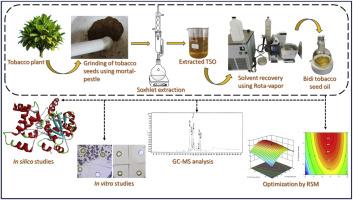Optimization of extraction efficiency employing response surface methodology, phytochemical screening, in-vitro antibacterial and antioxidant activity, in-silico studies of tobacco (Nicotiana tabacum) seed oil
IF 3.8
Q2 BIOTECHNOLOGY & APPLIED MICROBIOLOGY
引用次数: 0
Abstract
Nicotiana tabacum seed oil has extensive applications in fuel, cosmetic, and pharmaceutical sectors. This study investigates oil extraction from Bidi tobacco seeds (a variety found in Gujarat, India) using rarely utilized solvents—methylene dichloride (MDC), di-isopropyl ether, and n-butanol—alongside commonly used solvents like n-hexane and petroleum ether. Temperature, extraction time, and solid-solvent ratio were among the parameters that were optimized using a Box-Behnken Design. The solid-solvent ratio of 5.26 g/mL, 5.8 h, and 40 °C produced the maximum oil yield of 10.57 ± 0.04 %. Phytochemicals, including methasterone, linoleic acid, and sclareolide, were detected by GC-MS analysis. Oil extracted from MDC exhibited enhanced physicochemical characteristics. Bacillus cereus was found to be the most sensitive in the antibacterial test, with MICs for S. aureus and E. coli being 450 μg/mL and >500 μg/mL, respectively. At 250 μg/mL, the ABTS assay revealed 73.43 % antioxidant activity. Molecular docking confirmed the strong binding of methasterone to proteins in S. aureus and B. cereus.

利用响应面法优化烟草籽油的提取效率、植物化学筛选、体外抗菌和抗氧化活性、计算机研究
烟草籽油在燃料、化妆品和制药领域有广泛的应用。本研究调查了Bidi烟草种子(印度古吉拉特邦的一个品种)的油提取,使用很少使用的溶剂-二氯甲烷(MDC),二异丙醚和正丁醇-以及常用的溶剂,如正己烷和石油醚。采用Box-Behnken设计对温度、提取时间、固液比等参数进行了优化。料液比为5.26 g/mL,时间为5.8 h,温度为40°C,产油率最高为10.57±0.04%。GC-MS检测植物化学成分,包括美沙酮、亚油酸和核核内酯。从MDC中提取的油表现出增强的物理化学特性。对蜡样芽孢杆菌最敏感,对金黄色葡萄球菌和大肠杆菌的mic分别为450 μg/mL和500 μg/mL。在250 μg/mL浓度下,ABTS实验显示抗氧化活性为73.43%。分子对接证实了美沙酮与金黄色葡萄球菌和蜡样芽孢杆菌蛋白的强结合。
本文章由计算机程序翻译,如有差异,请以英文原文为准。
求助全文
约1分钟内获得全文
求助全文
来源期刊

Biocatalysis and agricultural biotechnology
Agricultural and Biological Sciences-Agronomy and Crop Science
CiteScore
7.70
自引率
2.50%
发文量
308
审稿时长
48 days
期刊介绍:
Biocatalysis and Agricultural Biotechnology is the official journal of the International Society of Biocatalysis and Agricultural Biotechnology (ISBAB). The journal publishes high quality articles especially in the science and technology of biocatalysis, bioprocesses, agricultural biotechnology, biomedical biotechnology, and, if appropriate, from other related areas of biotechnology. The journal will publish peer-reviewed basic and applied research papers, authoritative reviews, and feature articles. The scope of the journal encompasses the research, industrial, and commercial aspects of biotechnology, including the areas of: biocatalysis; bioprocesses; food and agriculture; genetic engineering; molecular biology; healthcare and pharmaceuticals; biofuels; genomics; nanotechnology; environment and biodiversity; and bioremediation.
 求助内容:
求助内容: 应助结果提醒方式:
应助结果提醒方式:


